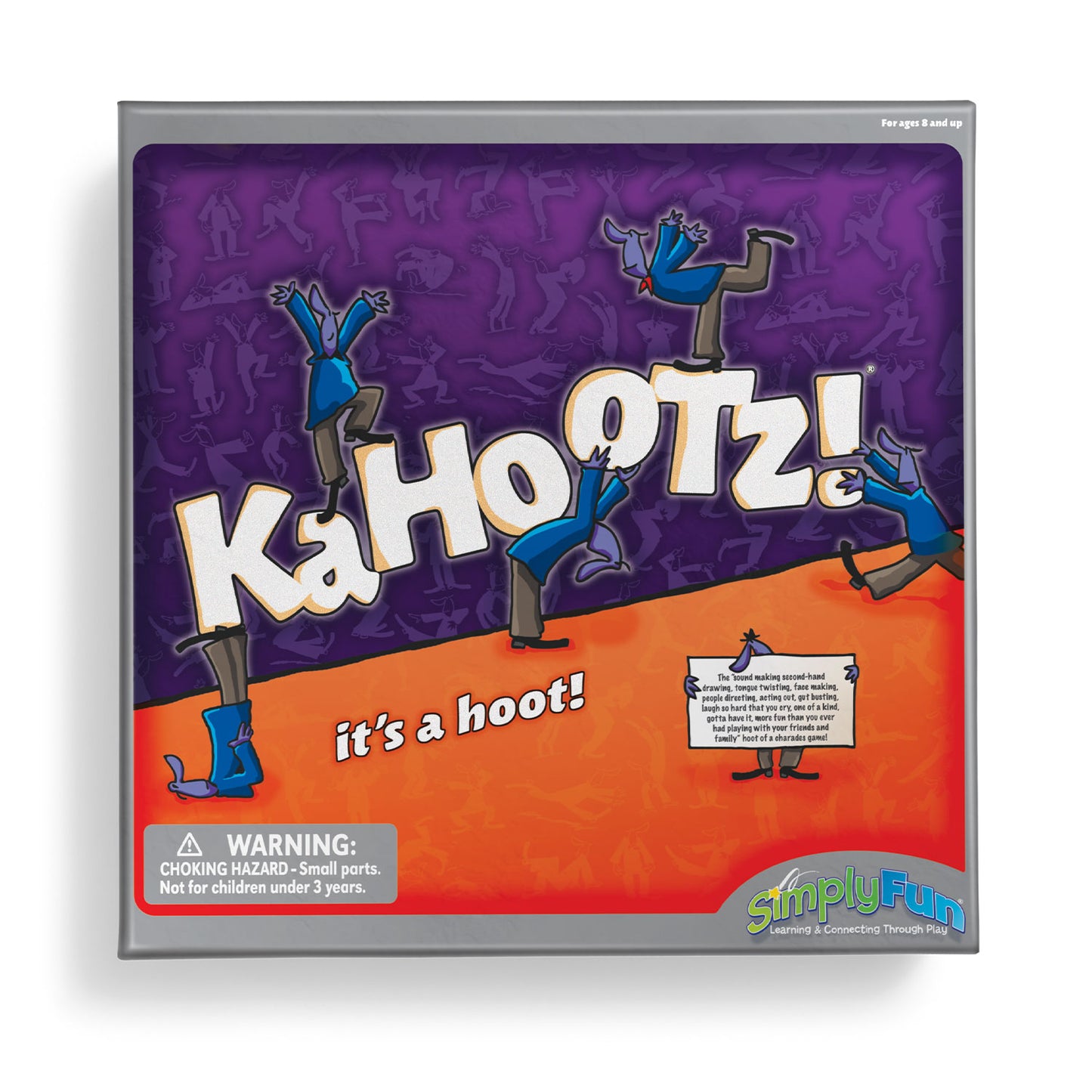
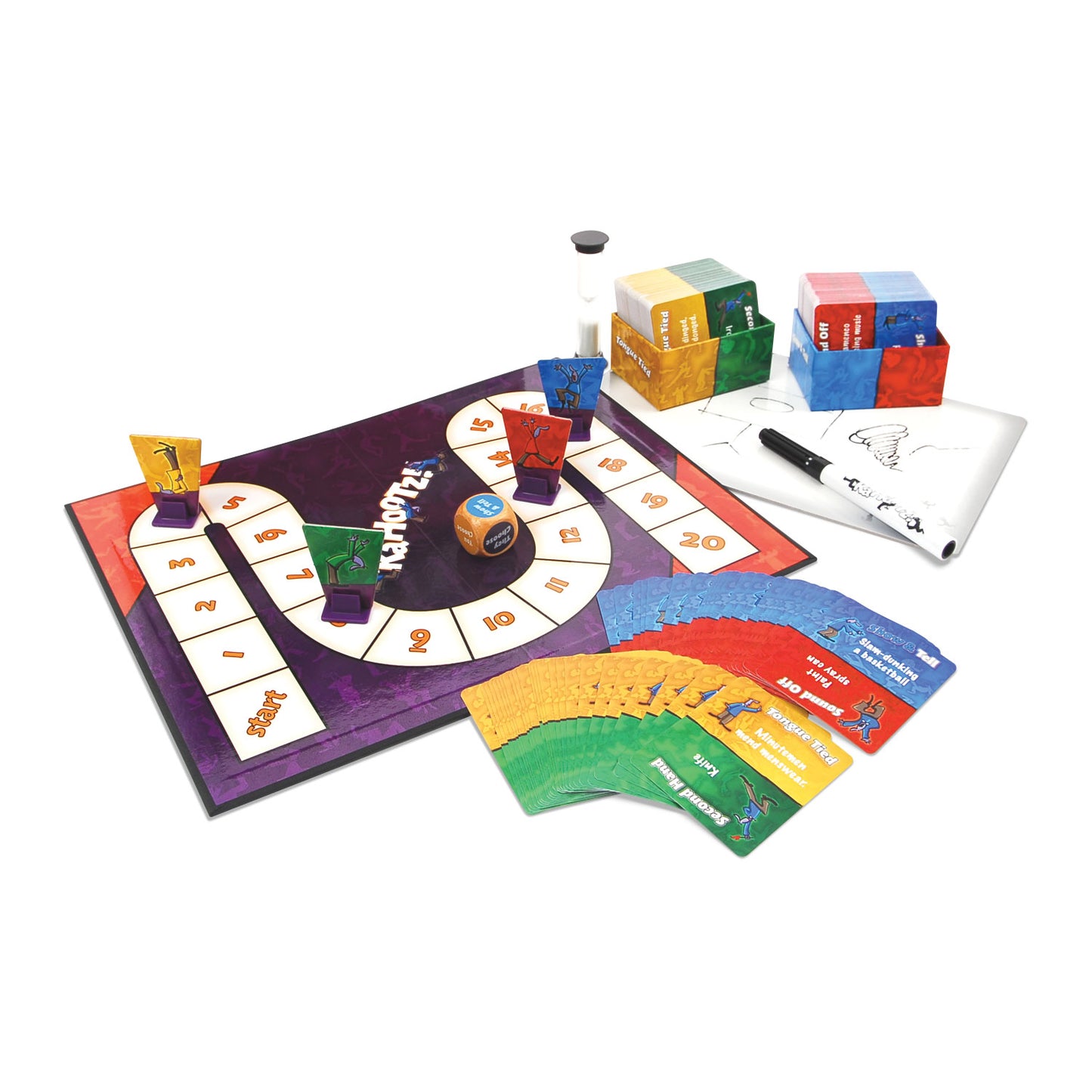
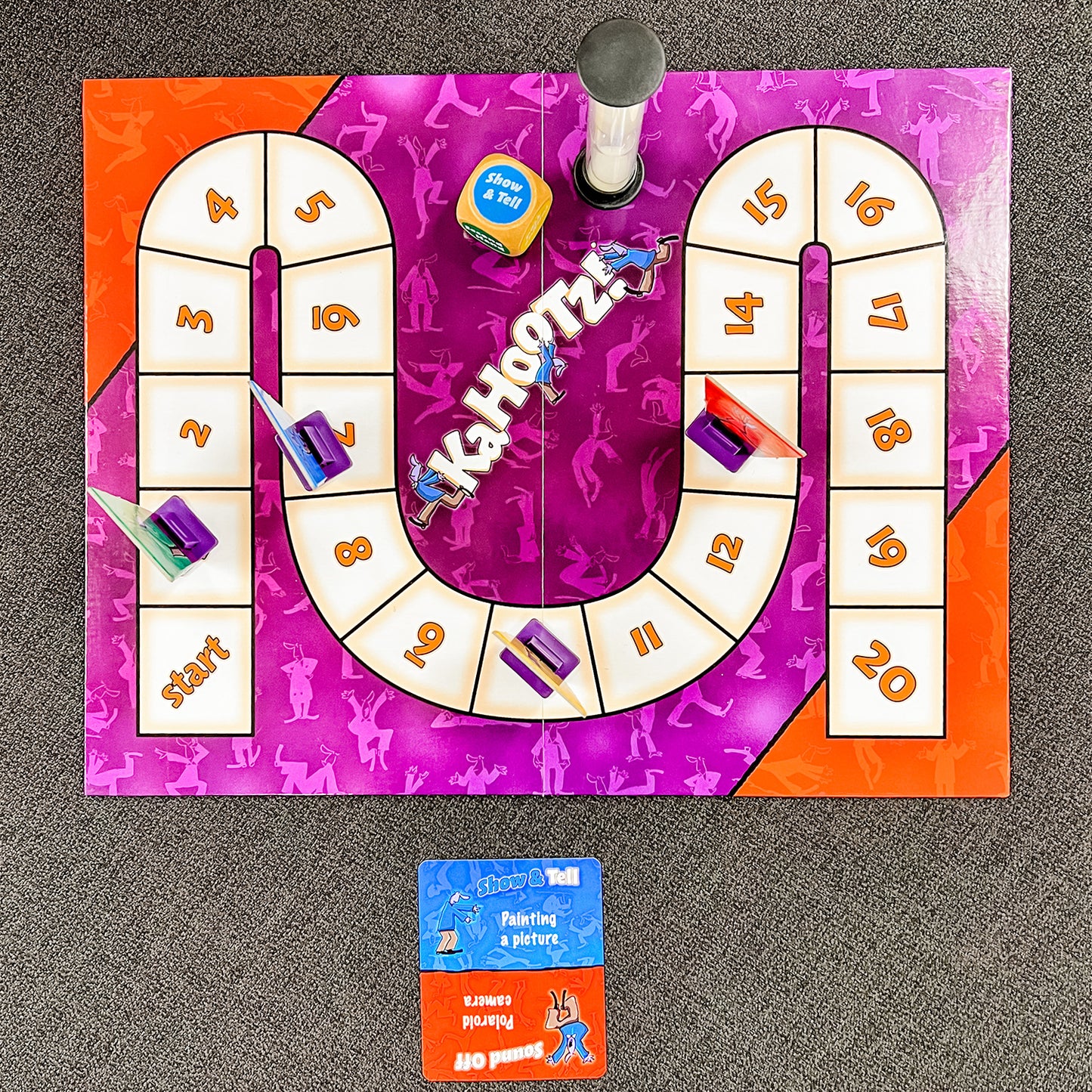

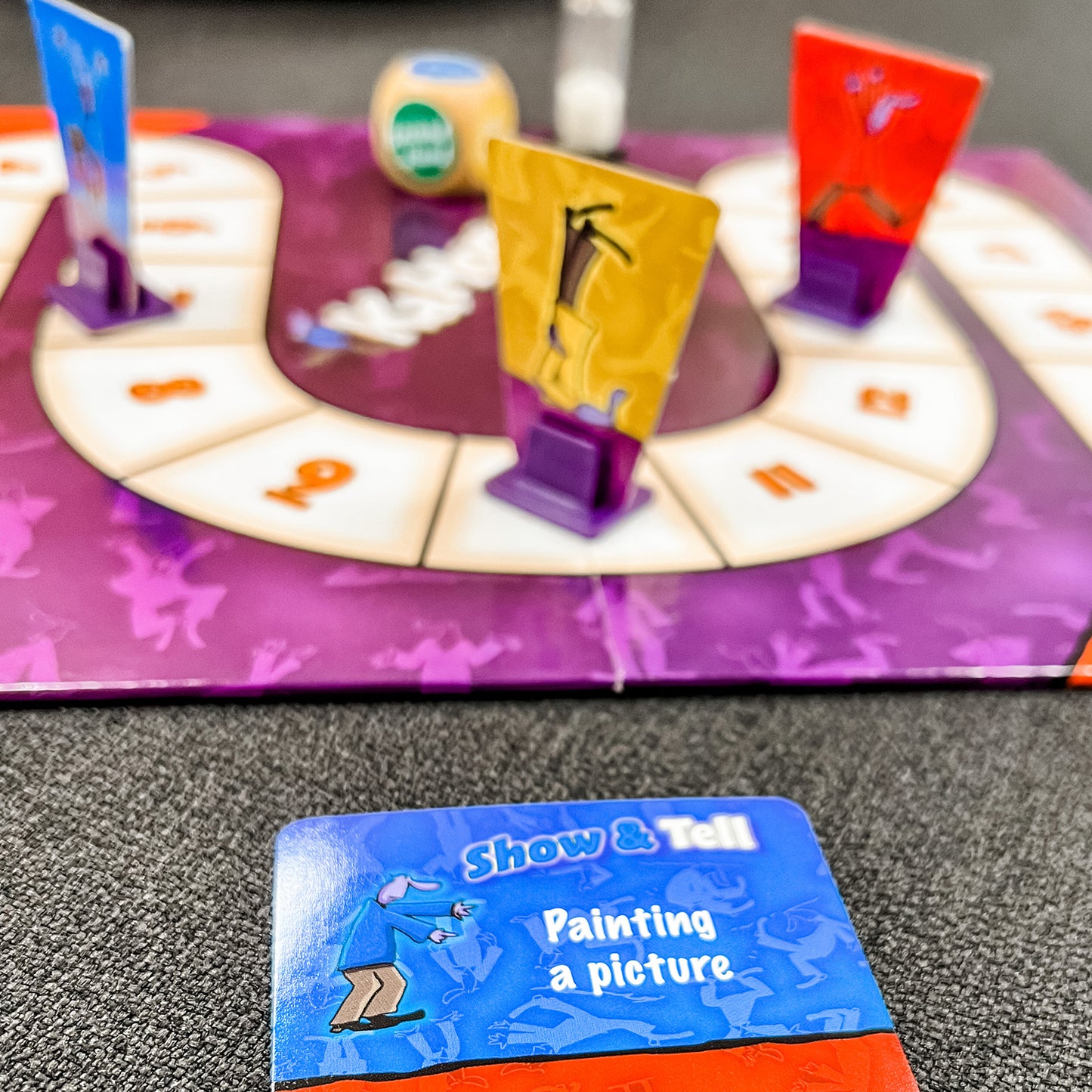
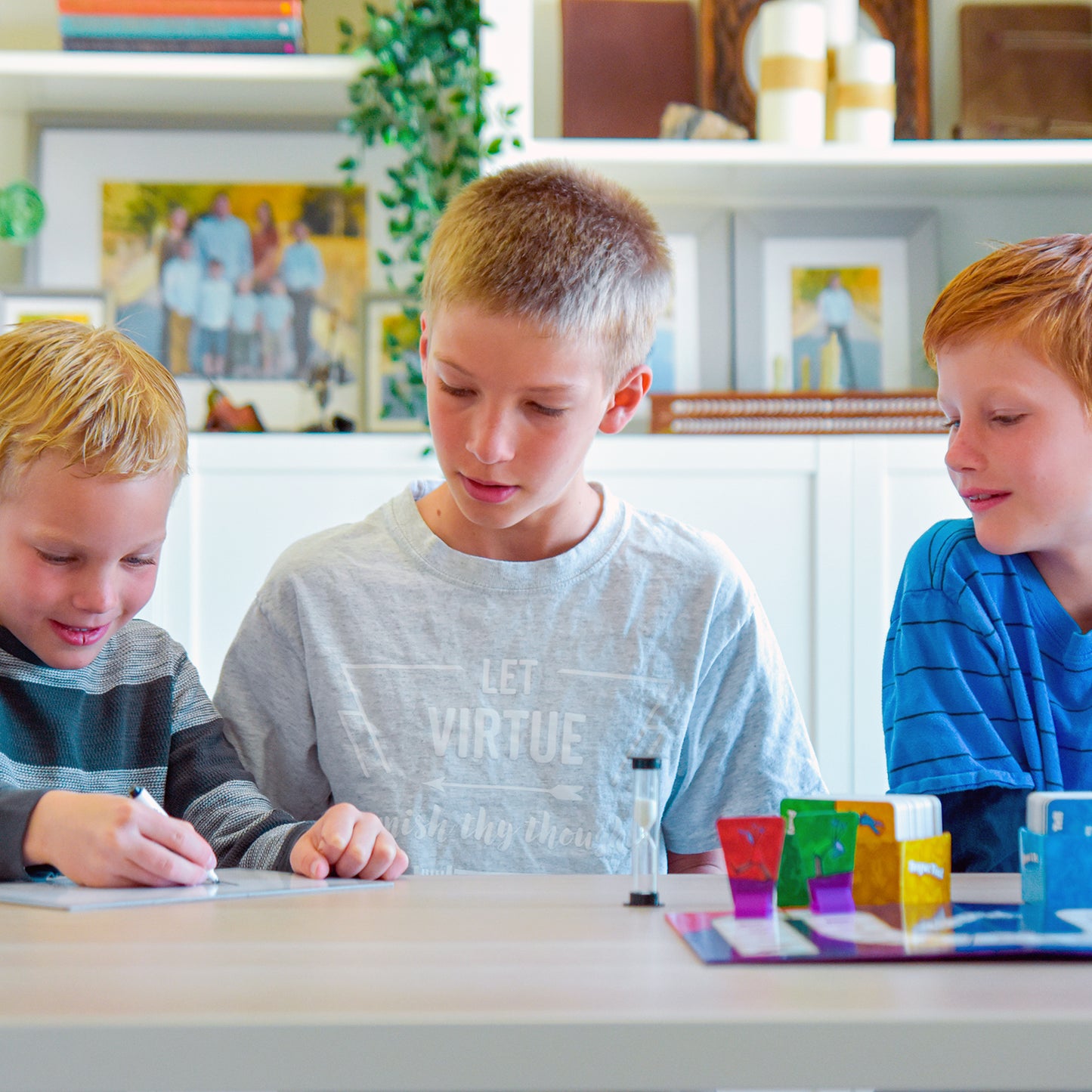
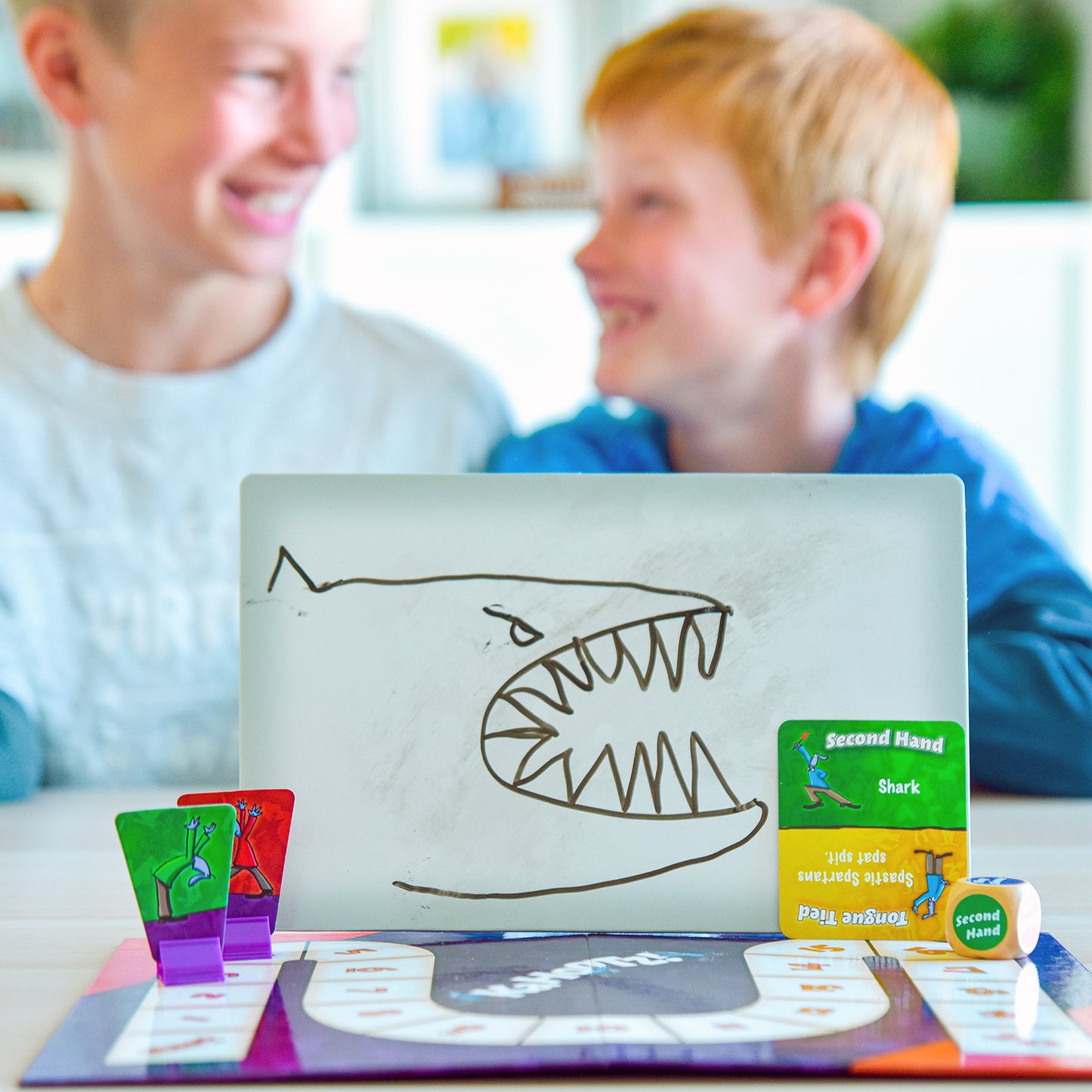
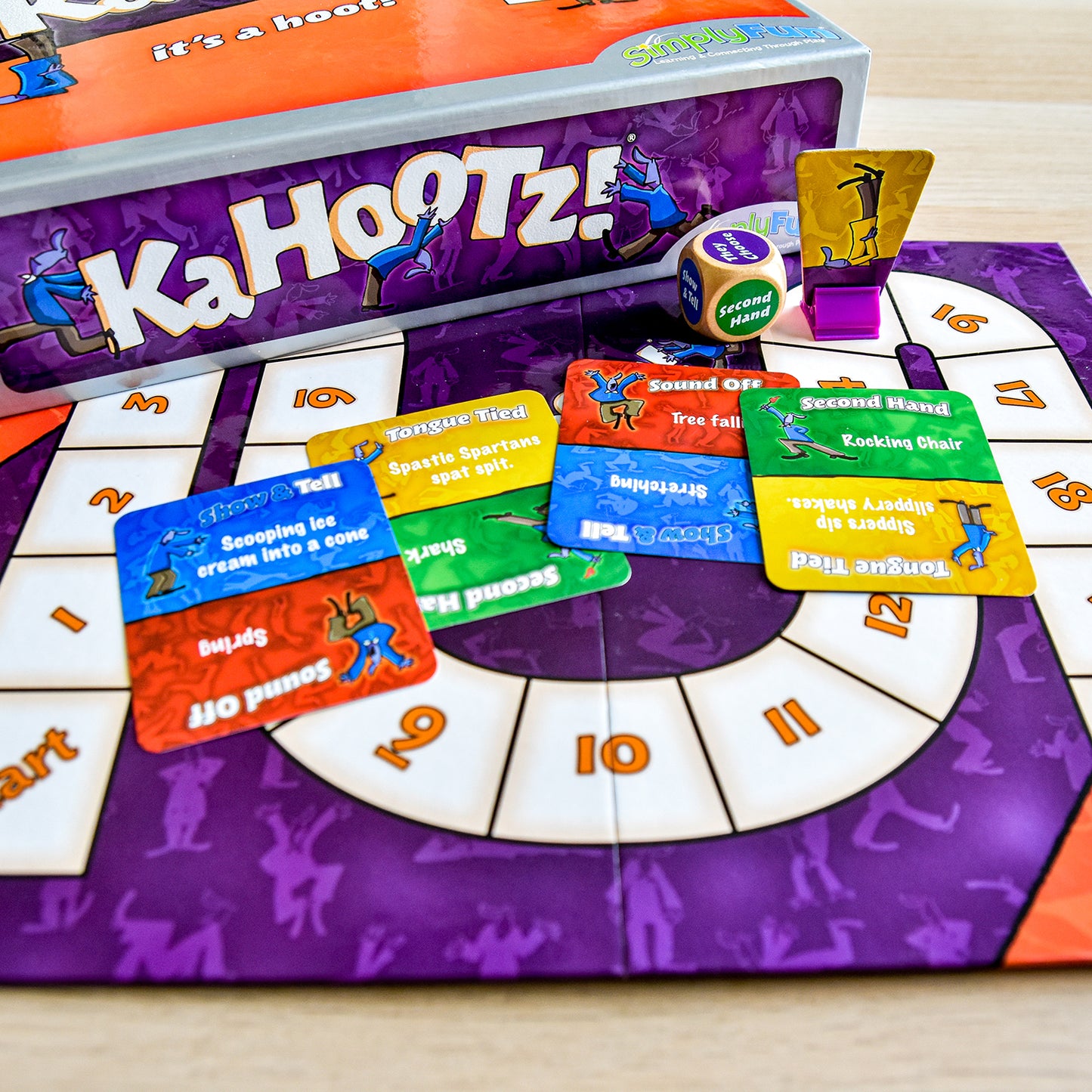
Collapsible content
Today, we’re going to take a look at Simply Fun’s Kahootz, the sound making, tongue twisting, second-hand drawing, face making, people directing, gut busting, more-fun-than-you-ever-had-playing-with-your-friends-and-family, HOOT of a charades game. Whew!
Kahootz is played with a minimum of 6 players. The maximum number of players is only limited by the size of your living room! Players should be 8 years old or older.
Kahootz comes with:
• 380 Kahootz action cards
• four team Pawns
• one Scoreboard
• one 1-minute sand timer
• one Kahootz die
• one dry erase board
• one dry erase marker
• one rules booklet
Kahootz includes 5 fun game-activities:
1. Sound Off
2. Second Hand
3. Tongue Tied
4. Show, and
5. Tell
Each activity pits one team against another in a quest to guess the correct answer to the selected charade in a race against the sands of time. Well, at least against the hourglass…
To set up the game, lay out the Scoreboard and place the Kahootz Actions cards on it.
Next, place the team Pawns on the start space of the board. Have the die, hourglass, and dry erase board handy.
To get started, form into teams of equal numbers, if possible, and have the first player on the starting team roll the die and draw the Kahootz Action card category as instructed. If “You Choose” comes up, the next team in line selects the category to be played.
Depending on the category drawn, the rules of game play may change. For example, in Sound Off, Second Hand, Show and Tell, only the active team may guess the answer. In Tongue Tied, all teams play at once.
When the active player is ready to begin, he turns over the hourglass timer and performs the action on the card.
If the Sound Off, Second Hand, Show or Tell category is chosen, the performing player reads the selected card to himself, and then, when ready, turns the timer over and begins.
In Tongue Tied, the performing player shares the card with the performing players of the other teams. When everyone is ready, each performer tries to get his own team to guess the correct answer in a race against time – and the other teams.
After completing an action, the die is passed to the next team and play continues.
To score, teams must make correct guesses before time runs out. When playing any game EXCEPT Tongue Tied, a correct guess by the active team scores 2 points. If the performing team is unable to guess within the allotted time, the inactive team gets one chance to guess correctly. If they are successful, they score one point.
In Tongue Tied, when all teams play at once, the first team to complete the action scores two points.
As points are scored, teams move their pawns forward on the Scoreboard. The first team to score twenty points and reach the end of the board wins.
Now, let’s take a quick look at the rules for each individual activity:
1. For Sound Off, players may only communicate with their voices. No hand gestures, body movements, toe-tapping, or finger snapping allowed. However, you can change up your intonation and timbre to help communicate! !
2. For Second Hand, players use the dry erase board and marker to draw the clue. With their non-dominant hand! Lefties draw right handed and righties draw left handed. Redrawing is OK, but no using your “good” hand!
3. Show… And Tell. This is not your typical kindergarten Show & Tell. It’s one or the other. If a player draws “Show” he must communicate only with facial expressions – no sounds or body movements. Do you promise to use your face, and nothing but your face? You’re on.
4. If the player draws “Tell” he must direct the next player on his own team to perform the action by telling him what to do without using the phrase on the card. For example, if the card said Opening a Door, the player could not say, “Open a door.” Rather, he would direct his teammate to do things like “reach out with your arm” and “make a turning motion with your hand” and “pull your hand toward your body.”
5. Finally, in Tongue Tied, performing players each read the tongue twister on the card silently. When each team is lined up , the performing player begins to whisper the phrase into the ear of the next person in line on their team. Whispering goes around until all players have heard it and the last player recites it aloud. The first team to recite the tongue twister correctly wins the round.
Kahootz is a fun party game that builds collaboration skills. Remember, teams do better when everyone is in Kahootz!


Core Standard*: Language
Language
- Foundational Skills
- Phonics and Word Recognition Grade Level 3rd
- Speaking and Listening
- Comprehension and Collaboration Grade Levels 3rd, 4th
- Presentation of Knowledge and Ideas Grade Level 4th
- Language
- Conventions of Standard English Grade Level 4th
- Knowledge of Language Grade Level 4th
- Vocabulary Acquisition and Use Grade Level 4th


Determine
What Does Child Do To Use Skill In The Game?
Players need to look at what the Performer is drawing, listen to sounds they are making or observe the facial expressions they are making.
How Parents Can Assist Learning
No special parent support required.
Learning Implications and Educator Support
Kahootz! helps chidren develop observation and visualization skills as they look at and interpret the actions, drawings or verbalizations of their partner(s).
Compare
What Does Child Do To Use Skill In The Game?
Players will compare drawings, sounds and facial expressions with remembered images, sounds and facial expressions.
How Parents Can Assist Learning
No special parent support required, however, parents may want to remove some cards that they believer would be too difficult for children.
Learning Implications and Educator Support
Kahootz! involves advanced versions of comparison, namely, visual-memory for the drawings, auditory-memory for the sounds, and visual-memory combined with emotional-memory for the facial expressions. These types of comparison are advanced because children need to compare something being experienced with something that is remembered.
Remember
What Does Child Do To Use Skill In The Game?
Players need to use their memory throughout the game. The Tongue Tied cards require active short-term memory use. The other cards require players to recall images, emotions, actions and other experiences from their past in order to correctly guess what the Performer is doing.
How Parents Can Assist Learning
If a child who is a Performer does not know something on the card they drew (ex: Pro Photographer's Camera), allow they to discard and draw another card.
Learning Implications and Educator Support
Kahootz! helps develop or reinforce visual, physical and auditory memory.
Plan
What Does Child Do To Use Skill In The Game?
Performers need to quickly plan how to execute the actions required, other than for Tongue Tied.
How Parents Can Assist Learning
No special parent support required.
Learning Implications and Educator Support
Playing Kahootz! Helps develop quick thinking skills as children either make quick plans (ex: motor planning to draw something in Second Hand) or respond quickly to partners.The planning, execution of the plan and adapting to the responses of one's partners helps children develop a range of social cognition skills like observation, cooperation, and giving and following directions.
Experiment
What Does Child Do To Use Skill In The Game?
If players are not guessing correctly, players may change what they are doing. For example, a Performer may erase a drawing no one can guess and start all over with a different approach.
How Parents Can Assist Learning
If you observe a child getting stuck, encourage him or her to try something completely different. For example, if drawing a "chainsaw" is not working, the child could try to draw a chain on a bicycle and a hand saw. Then try to get their partner to combine "chain" and "saw" together. Parents can tell children to try breaking down the problem by thinking of different parts of the words or different ways to think of the words.
Learning Implications and Educator Support
Changing perspective is a powerful experimentation technique that supports innovative thinking and creative problem-solving. Encourage children to think about their partner's interests or ways of communicating. This can help them think of different ways to draw, act, or make sounds that their partner will accurately guess.Willingness try new things and adaptability are also important experimentation skills. For example, if you observe a child getting stuck, encourage him or her to try something completely different. For example, if drawing a "chainsaw" is not working, the child could try to draw a chain on a bicycle and a hand saw. Then try to get their partner to combine "chain" and "saw" together. Encourage children to change perspective if something is not working.
Solve
What Does Child Do To Use Skill In The Game?
Players figure out how many ice chunks are needed to make a Journey, and solve the game's objectives when they successfully make a Journey.
How Parents Can Assist Learning
No special parent support required.
Learning Implications and Educator Support
As children play they learn new information constantly as different Ice Hop cards are selected, played and removed. This information directly effects how children strategize an approach for sequencing and playing their cards to make winning Ice Floe Journeys.Encourage children to remain flexible in their approach to the game. It is difficult to predict what opponents will do. Thus, it is important to adapt based on prior moves. Adapting is key to building resilience and creative problem solving.
Review
What Does Child Do To Use Skill In The Game?
Players may review if encouraged. See How Parents Can Assist Learning.
How Parents Can Assist Learning
Although not required, it is fun to discuss activities after they are complete. What worked? What was hard?
Learning Implications and Educator Support
Although not required, it is fun to discuss activities after they are complete. What worked? What was hard? Analysis of process can help children learn from each other.
Demonstrate
What Does Child Do To Use Skill In The Game?
Performers will demonstrate through words, physical motion, drawing, sounds and facial expressions in an effort to get their teammates to make accurate guesses.
How Parents Can Assist Learning
No special parent support required. However, if a child does an especially good job performing or guessing, give the child a high five and ask them to tell everyone how they figured it out or came up with the awesome sound, drawing or other performance. Positive reinforcement helps build self-esteem and confidence.
Learning Implications and Educator Support
No special educator support required. However, if a child does an especially good job performing or guessing, give the child a high five and ask them to tell everyone how they figured it out or came up with the awesome sound, drawing or other performance.
Imagine
What Does Child Do To Use Skill In The Game?
Kahootz! engages players imaginations when any card, other than Tongue Twister, is played. Performers need to imagine what to draw, or how to make a certain face, or what sounds will elicit the correct guess. Players will often imagine what the Performer is going to draw, and make guess before the drawing is complete.
How Parents Can Assist Learning
Encourage kids to be as wildly imaginative as they want! And, parents should, too!
Learning Implications and Educator Support
Imagination is the partner to creativity, i.e. high quality creativity is dependent on high quality imagination. Imagination is critical in everything from developing long-term successful relationships to inventing the cure for cancer to solving day-to-day problems where old methods do not work well any more. Playing Kahootz! is great for helping children strengthen their imagination skills across a range of domains from visual to emotional.
Create
What Does Child Do To Use Skill In The Game?
After imagining what they are going to do, Performers need to create what they imagined. For example, the Performer needs to make a face for "ashamed". thye might imagine something that would make them ashamed, think about what other people look like when ashamed, and then try to create an "ashamed" face.
How Parents Can Assist Learning
Creativity is the most complex and advanced thinking skill. Kahootz! helps children explore a range of creative modes, namely, words, sounds, drawing, body language and movement and facial expressions. Creativity is not limited to poetry or art!
Learning Implications and Educator Support
Creativity is the most complex and advanced thinking skill. Kahootz! helps children explore a range of creative modes, namely, words, sounds, drawing, body language and movement and facial expressions. Creativity is not limited to poetry or art!An important characteristic of creativity is fluency, i.e. the ability to generate many different ideas. Kahootz! often makes Performers create different ideas because their partners cannot guess accurately on the first few tries.
*Data compiled from CCSSI ELA Standards, WA Science Standards, and Washington Social Studies Standards


Cognitive
Suggestions for How to Modify Play Experience
The following modifications may be beneficial for children with cognitive delays:
Show and Tell: No modifications are needed unless the child needs an explanation of the emotion named.
Sound Off: No modifications are needed unless the child needs an explanation of the item named.
Second Hand: Children with Down Syndrome or other moderate cognitive delays may also have fine motor problems. Allow them to use their preferred hand.
Tongue Tied: Children with Down Syndrome or other syndromes associated with cognitive delays may have articulation disorders or oral motor problems impeding speech production. Omit these cards in this case. Children without such speech issues may be able to do the tasks.
Communication
Suggestions for How to Modify Play Experience
The following modifications may be beneficial for children with communication delays:
Show and Tell: Children should be able to do the Show Cards, but the Tell cards require children to describe what needs to be done without using key words. This task may be challenging for children with "word-finding" issues. Also, finding a synonym or alternative words to describe a situation can be difficult. However, this activity is very useful for these children, so eliminate the timer to give the child adequate time to think. An adult may also want to monitor and provide support for this child by helping him or her think of some clues to give before the timer starts.
Sound Off: This activity is good practice for children with articulation disorders. It encourages them to make a variety of sounds without the pressure of making sounds in speech production.
Second Hand: Children with language concerns should be able to play these cards.
Tongue Tied: Omit these cards for children with articulation disorders. Adults may want to use these cards separately as a speech game with the child.
Sensorimotor
Suggestions for How to Modify Play Experience
The following modifications may be beneficial for children with sensorimotor concerns:
Show and Tell: Performing the actions on these cards is good practice for children with fine and gross motor delays. The facial expressions require movements of the muscles in the face, while the other actions are all functional actions. Performing these actions is good practice for real life actions.
Sound Off: These cards provide a fun way to practice oral motor movements, which are often difficult for children with high or low muscle tone. Such practice helps exercise facial muscles.
Second Hand: For children with fine motor concerns, eliminate these cards or, if their drawing is recognizable, let them use their preferred hand.
Tongue Tied: If children have oral control issues, omit these cards.
Social Emotional/Behavioral
Suggestions for How to Modify Play Experience
The following modifications may be beneficial for children with social and/or emotional concerns:
Show and Tell: The Show Cards are particularly good for children with autism, as these children often have difficulty demonstrating emotional expressions or recognizing emotions in others. Avoid using the timer when using this KaHootz category with children with autism. And encourage them to generate the expressions independently. If they are not able to do this, the adult can model the emotion for them and have them imitate it. For children with other emotional issues, these expressions may not be difficult to make, but they may use them inappropriately in their real life. A modification would be to eliminate the timer and have the other players react to the emotions as they are expressed. For example, "Oh, you are scaring me! Are you showing me mean? Angry? Unhappy?" Children need to recognize that others read their emotions even without accompanying actions. After the game, adults may take the opportunity to talk about some of the emotions and when they feel them. This also provides a time to discuss what to do when feeling these emotions and what are appropriate emotional outlets.
Sound Off: This is a good social game as long as children don't think they are being laughed at when they make noises. Children who are shy may take the laughter personally. Make sure the child notices that everyone's noises get laughed at. For example, if everyone laughs, say, "My noise was funnier than theirs!" This points out that laughing is good.
Second Hand: No modifications required.
Tongue Tied: No modifications required.
Vision
Suggestions for How to Modify Play Experience
The following modifications may be beneficial for children with low vision: Show and Tell: Someone needs to read the card to the child and give clues if the child is unfamiliar with the items listed. If a card is too difficult or unfamiliar, draw another cards.
Sound Off: This may be something the child with vision concerns excels at. Children may be very in tune with sounds, although making the sounds may be more difficult. Support the child by giving reinforcement as they make sounds.
Second Hand: Omit these cards.
Tongue Tied: Children should be able to do this well. They are used to listening carefully.
Hearing
Suggestions for How to Modify Play Experience
Children with hearing impairment cannot play all of the games unless all players use sign or the same type of communication system. They may be able to do the Tell and Second Hand cards.
*Data compiled from CCSSI ELA Standards, WA Science Standards, and Washington Social Studies Standards


Autism Special Considerations
Appears to ignore other's communication and/or has difficulty giving eye contact to a communication partner
Is This Game Appropriate for Child with Characteristic? No
Can Child with Characteristic Play Game w/o Modification?
Strategies for Developing Compensatory Skills:
Paying attention to others is essential in Kahootz. Children who cannot listen to or watch others' actions will not be able to play this game successfully.
Has difficulty understanding complex verbal directions
Is This Game Appropriate for Child with Characteristic? No
Can Child with Characteristic Play Game w/o Modification?
Strategies for Developing Compensatory Skills:
Directions for the game change frequently. New actions are required with each new category. In addition, speed is required. The game is not recommended for children who have difficulty following verbal directions or imitating actions.
Uses vocabulary inaccurately or demonstrates echolalia (repeating another's speech)
Is This Game Appropriate for Child with Characteristic? No
Can Child with Characteristic Play Game w/o Modification?
Strategies for Developing Compensatory Skills:
Children who have echolalia often have difficulty attending to others' meaning or intentions. Not recommended for these children.
Gets stuck repeating a verbal topic or physical actions and/or has difficulty attending to others' actions or topic.
Is This Game Appropriate for Child with Characteristic? No
Can Child with Characteristic Play Game w/o Modification?
Strategies for Developing Compensatory Skills:
Kahootz is not be appropriate for children who can't attend to others actions or words.
Has difficulty producing speech/communication
Is This Game Appropriate for Child with Characteristic? No
Can Child with Characteristic Play Game w/o Modification? No
Strategies for Developing Compensatory Skills:
Many of the tasks in the game require producing complex levels of language. The game is not recommended for children with language production concerns.
Has difficulty sequencing multi-step actions and/or doing complex abstract tasks
Is This Game Appropriate for Child with Characteristic? No
Can Child with Characteristic Play Game w/o Modification?
Strategies for Developing Compensatory Skills:
Children have to keep several social rules in mind at all times, and these rules change frequently. The game is not recommended for children who cannot pay attention to and follow complex social rules.
Demonstrates difficulty initiating and maintaining social interactions
Is This Game Appropriate for Child with Characteristic? No
Can Child with Characteristic Play Game w/o Modification?
Strategies for Developing Compensatory Skills:
Maintaining social interaction is required throughout the game, so it is not recommended for children with this issue.
Acts out or demonstrates avoidance behaviors when frustrated, overwhelmed, or needs more sensory input.
Is This Game Appropriate for Child with Characteristic? No
Can Child with Characteristic Play Game w/o Modification?
Strategies for Developing Compensatory Skills:
Not recommended for children who are easily frustrated or overwhelmed.
Has short attention span for non-preferred activities
Is This Game Appropriate for Child with Characteristic? No
Can Child with Characteristic Play Game w/o Modification?
Strategies for Developing Compensatory Skills:
Not recommended for children who only want to do preferred activities, as this involves social conversation, which is typically difficult for children with special needs.
Needs sameness or consistent routines and/or has difficulty with transitions from one activity to another
Is This Game Appropriate for Child with Characteristic? No
Can Child with Characteristic Play Game w/o Modification?
Strategies for Developing Compensatory Skills:
Constant change in the game actions would make this game too challenging for children who have difficulty with transition.
Has difficulty understanding others' feelings, intentions, and the reasons for others' actions.
Is This Game Appropriate for Child with Characteristic? No
Can Child with Characteristic Play Game w/o Modification?
Strategies for Developing Compensatory Skills:
Children need to constantly monitor their actions and those of others. Not recommended for children who have difficulty doing this.
*Data compiled from CCSSI ELA Standards, WA Science Standards, and Washington Social Studies Standards


Extra Ways to Play the Game
This variation is played without the Tongue Tied category. Each team in turn sees how many of one category they can correctly answer in two minutes. For example, Player Number One on the first team draws a Show Card and does what it says on the card. As soon as the rest of their team guesses the answer, that team scores a point. Player Two on this team draws a card, and so on. The other team watches and turns the timer twice and shouts "Stop!" when two minutes is up. Any player who draws a card can reject the card and draw another, but a point is lost on the board. The second team then rolls the die, and proceeds in the same way with the category they rolled. (If Tongue Tied is rolled, keep rolling until another category comes up.) The game continues until one team reaches the end. An option to this variation is to roll the die after each player's turn to potentially change the category. The teams should agree on which version they want to play.
Materials Needed
No additional materials needed.
Developmental Benefits
The timed team version adds a element of tension for the team all at one time. This makes them generate more responses quickly, so they increase thinking speed. Teams also encourage each other and build off each other's responses.
*Data compiled from CCSSI ELA Standards, WA Science Standards, and Washington Social Studies Standards









